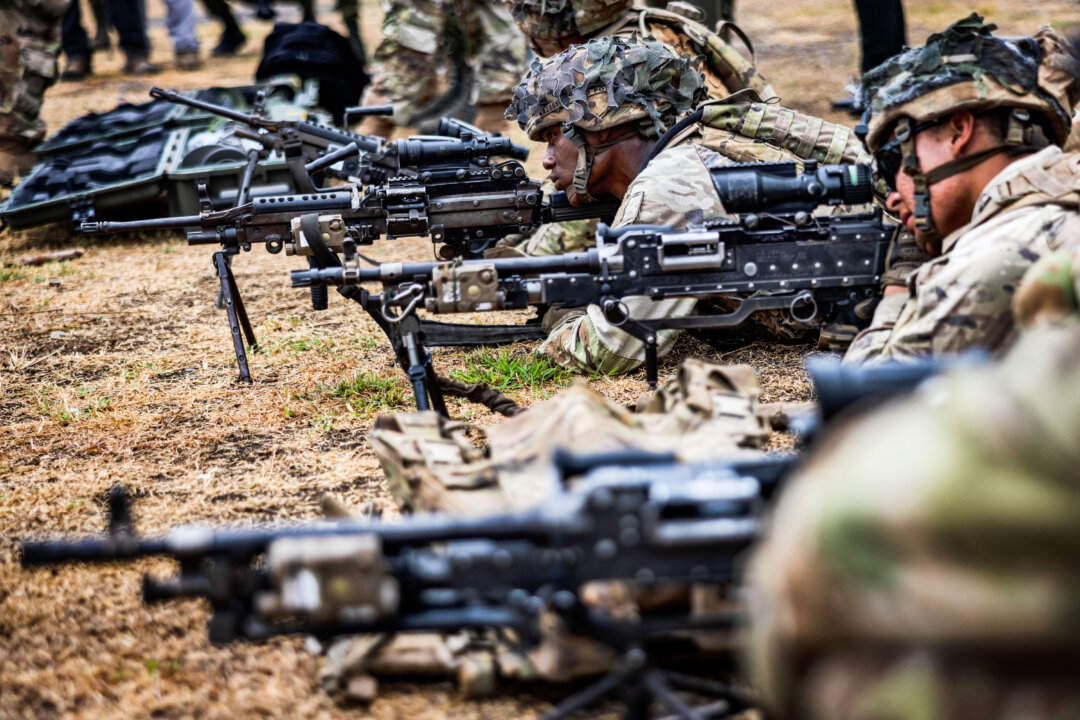The Philippines has faced confrontations with Beijing over disputed areas of the South China Sea.
The United States and the Philippine militaries are conducting annual joint combat exercises simulating the defense of the Philippine archipelago, as two allies seek to deter China’s growing assertiveness in the region.
The Balikatan exercises, a long-running series of U.S.-Philippine military drills grounded in a mutual defense treaty, began on April 21 and will run through May 9, involving approximately 9,000 American and 5,000 Filipino personnel.
This year’s drills will feature fighter jets, warships, and a range of advanced weaponry. For the first time, they will include the Navy-Marine Expeditionary Ship Interdiction System (NMESIS), a mobile anti-ship missile system recently deployed on islands in the Luzon Strait, a strategic waterway separating the northern Philippines from Taiwan.
According to the U.S. Marines, NMESIS offers enhanced sea-denial capability, strengthens land-sea integration, and improves deterrence by expanding the range of targets the Joint Force can engage from both land and sea. Its deployment follows the staging of the Typhon mid-range missile system in the northern Philippines in April of last year.
“We will demonstrate not just our will to uphold our mutual defense treaty in existence since 1951 but our matchless capability to do so,” Marine Corps Lt. Gen. James Glynn, the U.S. exercise director, said at the opening ceremony in Manila.
“You have found through your experience up until this point that nothing builds bonds more quickly than shared adversity,” Glynn said, although he stopped short of identifying any specific threat.
The joint exercises take place amid rising tensions in the South China Sea and around Taiwan, just north of the Philippines, where Beijing has been increasingly aggressive in asserting its territorial claims.
In fact, just hours before the start of this year’s Balikatan drills, the Chinese navy stated it had expelled a Philippine warship it accused of having “illegally intruded” into waters near a disputed shoal in the South China Sea.
This wasn’t the first time the Philippines had a confrontational encounter with Chinese forces in these contested waters. Beijing has been accused of using water cannons, military-grade lasers, and maritime maneuvers to harass Philippine vessels in an effort to assert its sweeping territorial ambitions—claims that were rejected by a 2016 international tribunal ruling, which China continues to ignore.
Under former President Rodrigo Duterte, the Philippines pursued a China-friendly policy, halting joint maritime patrols with the United States and even threatening to scrap an accord that was key to maintaining a U.S. military presence in his country. Duterte sought to leverage Chinese investments and infrastructure financing under Beijing’s Belt and Road Initiative, and proposed joint resource exploration in contested waters. Those efforts eventually didn’t yield the economic or diplomatic gains he had hoped for.
In 2021, a year before his retirement, Duterte dramatically reversed course and restored defense ties with Washington. His successor, President Ferdinand Marcos Jr., has continued that trajectory, expanding cooperation with the United States and pushing back against China’s maritime claims.
During a visit to Manila in late March, U.S. Defense Secretary Pete Hegseth reaffirmed Washington’s commitment to the alliance.
“Deterrence is necessary around the world, but specifically in this region, in your country, considering the threats from the Communist Chinese,” Hegseth told Marcos. “Friends need to stand shoulder to shoulder to deter conflict, to ensure that there is free navigation, whether you call it the South China Sea or the West Philippine Sea.”
“We are doubling down on that partnership, and our ironclad alliance has never been stronger,” he said.
In response to the drills, Beijing accused Manila of collusion with “countries outside the region” and of introducing “strategic and tactical weapons” that could disrupt “regional strategic stability.”
Foreign Ministry spokesperson Guo Jiakun at a press conference repeated China’s familiar warnings against “provoking” Beijing on the Taiwan issue. Both U.S. and Philippine officials have stated that the drills are not aimed at Taiwan.
The Chinese Communist Party (CCP)—which never ruled Taiwan—proclaims Taiwan as China’s renegade province and has not given up using force to unite the democratic island with the authoritarian mainland.
Considering the Philippines’ geographical proximity to Taiwan, officials have been concerned about the possibility of a Taiwan crisis.
On April 1, as China encircled Taiwan with military ships and aircraft during a simulated blockade, Philippine Armed Forces Chief of Staff Gen. Romeo Brawner said his country would “inevitably” get involved if “something happens to Taiwan.” Philippine officials later clarified that his comments primarily referred to the evacuation of overseas Filipino workers, not military intervention.
At Monday’s opening ceremony, Glynn and his Philippine counterpart, Maj. Gen. Francisco Lorenzo, both stressed that the Balikatan drills are not aimed at any specific country or scenario—including a potential invasion of Taiwan. However, they acknowledged that the exercises could help strengthen deterrence in a tense regional environment.
“What I would say is that there is no specific call out of an individual location or nation,” Glynn said. “This is not intended to be provocative in any way. This is intended to test, amongst 20 nations, our mutual integration, collaboration, and organizations that we’ve created.”
“Balikatan is not against any nation, but it is a joint training with the forces to increase our capability in securing our territory,” said Lorenzo. “And of course, it will increase our capabilities and our preparedness and responsiveness to any eventuality.”

